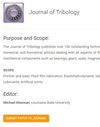316L不锈钢激光冲击喷丸冷喷添加剂的摩擦学性能
IF 3
3区 工程技术
Q2 ENGINEERING, MECHANICAL
引用次数: 4
摘要
近年来,冷喷涂增材制造(CSAM)已成为一种具有吸引力的表面改性和保护技术。然而,由于CSAM涂层固有的多孔性,它们由于摩擦学相互作用引起的过早脆性断裂而遭受材料的快速降解。在这项工作中,激光冲击喷丸(LSP)被用作一种后处理技术,以减轻CSAM 316L SS的表面孔隙率并增强其表面特性。由于严重的塑性变形和快速的表面加热的协同影响,表面孔隙率得到了有效的愈合,从而降低了表面粗糙度。结合LSP的表面强化作用,降低了CSAM LSP表面的摩擦阻力和转移层的形成。通过关联LSP表面的原子、微观结构和物理特征,讨论了这些发现的潜在机制。基于这些发现,可以表明LSP确实是一种控制CSAM 316L SS涂层表面特性的有用技术。本文章由计算机程序翻译,如有差异,请以英文原文为准。
Tribological Performance of Laser Shock Peened Cold Spray Additive Manufactured 316L Stainless Steel
In recent years, cold spray additive manufacturing (CSAM) has become an attractive technology for surface modification and protection. However, due to the intrinsic porous nature of CSAM coatings, they suffer from rapid material degradation due to premature brittle fracturing induced by tribological interactions. In this work, laser shock peening (LSP) was utilized as a post-processing technology to mitigate the surface porosity and augment the surface characteristics of CSAM 316L SS. Due to the synergistic influence of severe plastic deformation and rapid surface heating, the surface porosities were effectively healed, thus reducing the surface roughness. Combined with the surface strengthening effects of LSP, the frictional resistance and transfer layer formation on the CSAM LSP surfaces were reduced. The underlying mechanisms for these findings were discussed by correlating the atomic, microstructural, and physical features of the LSP surfaces. Based on these findings, it can be suggested that LSP is indeed a useful technique to control the surface characteristics of CSAM 316L SS coatings.
求助全文
通过发布文献求助,成功后即可免费获取论文全文。
去求助
来源期刊
CiteScore
4.20
自引率
12.00%
发文量
117
审稿时长
4.1 months
期刊介绍:
The Journal of Tribology publishes over 100 outstanding technical articles of permanent interest to the tribology community annually and attracts articles by tribologists from around the world. The journal features a mix of experimental, numerical, and theoretical articles dealing with all aspects of the field. In addition to being of interest to engineers and other scientists doing research in the field, the Journal is also of great importance to engineers who design or use mechanical components such as bearings, gears, seals, magnetic recording heads and disks, or prosthetic joints, or who are involved with manufacturing processes.
Scope: Friction and wear; Fluid film lubrication; Elastohydrodynamic lubrication; Surface properties and characterization; Contact mechanics; Magnetic recordings; Tribological systems; Seals; Bearing design and technology; Gears; Metalworking; Lubricants; Artificial joints

 求助内容:
求助内容: 应助结果提醒方式:
应助结果提醒方式:


